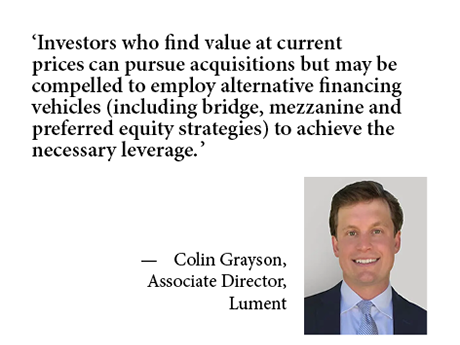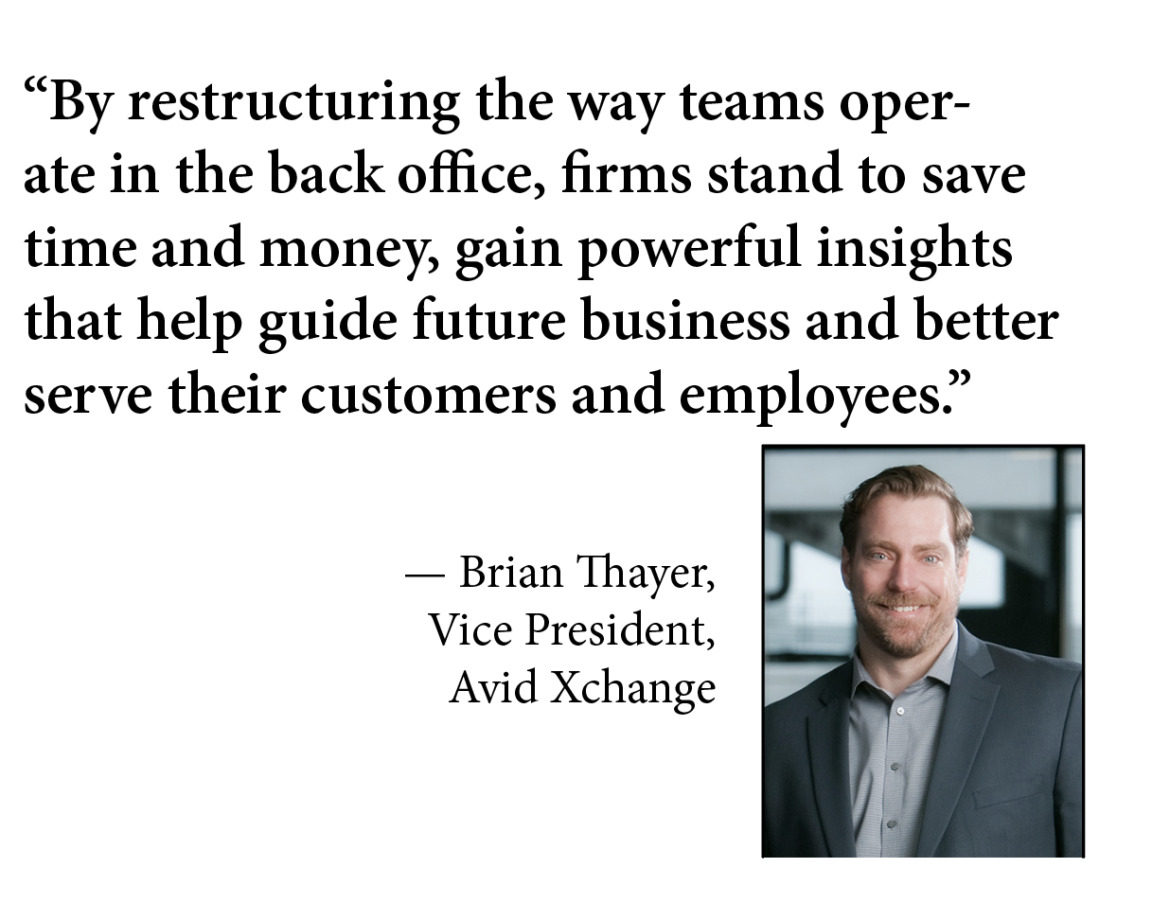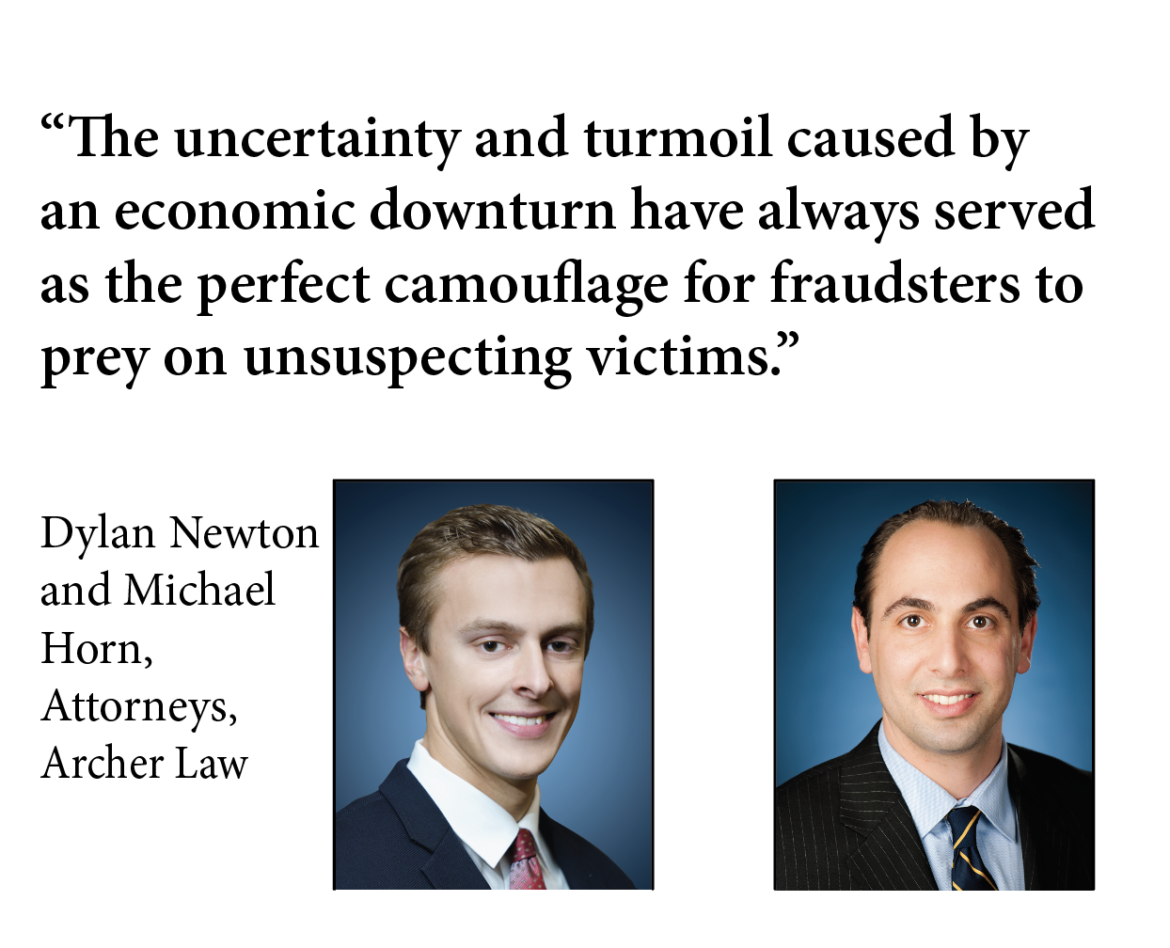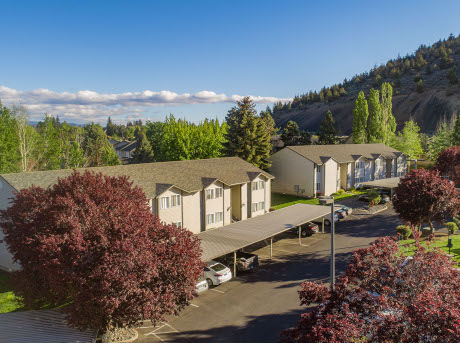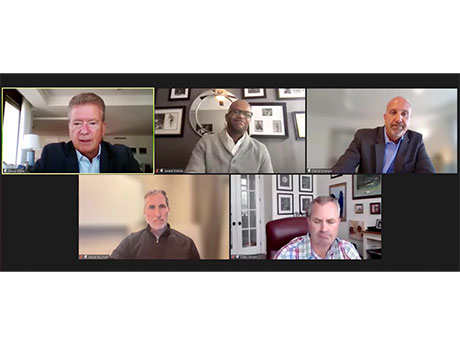By Colin Grayson, Lument If you consider multifamily real estate assets to be a good investment, you are in good company. At mid-year, asset managers and private equity firms alone held an estimated $325 billion of levered dry powder set aside for this purpose, enough cash to finance nearly every acquisition closed in the United States in 2021, the highest investment sales volume on record. Despite nearly unanimous support for the asset class, however, multifamily transaction volume in the third quarter slumped year-over-year for the first time since the peak of the pandemic. The mainspring was a sharp rise in mortgage financing costs triggered by high inflation and the Federal Reserve’s commitment to raising rates to bring it under control. Generic rates for 65 percent loan-to-value (LTV) first mortgage debt stood on 5.71 percent at the end of November, representing an increase of 248 basis points since the beginning of the year. Even as financing costs soared, asset pricing changed very little. Initial net cash flow yields of transactions closed in the third quarter of 2022 averaged only 4.6 percent, according to Real Capital Analytics, an increase of 10 basis points from second-quarter 2022 levels. At the same time, cap …
Features
By Brian Thayer of AvidXchange Rising inflation is tough on business. But it’s pushing finance teams to evaluate the way they work while also providing these teams opportunities to make changes that will benefit them long after the economy stabilizes. According to data from AvidXchange, 70 percent of finance professionals plan to adjust their budgets in response to inflation, with many looking for ways to reduce costs, work smarter and improve profit margins. Nearly half (48 percent) of those surveyed are prioritizing technology investments, and a third are looking to technology — including automation and artificial intelligence (AI) — to create efficiencies as they face a potential economic downturn. Real estate, an industry notoriously slow for embracing technological innovation, is well poised to make these investments in modernization. By restructuring the way teams operate in the back office, firms stand to save time and money, gain powerful insights that help guide future business and better serve their customers and employees. Modernizing will also help strengthen retention efforts to secure talent and seize new opportunities for growth. Here’s a closer look at how automation technology can help real estate firms future-proof their businesses amid rising inflation and a potentially looming recession. …
AcquisitionsArbor Realty TrustBuild-to-RentContent PartnerFeaturesMidwestMultifamilyNortheastSingle-Family RentalSoutheastTexasWestern
Investors Drawn to Single-Family Rentals During Tough Economic Times
By John Tarantino, Arbor Realty Trust The ongoing expansion of the single-family rental (SFR) market is capturing investors’ interest like never before. Construction starts in the sector topped a record 69,000 units over the past year, while the rate of rent growth remained positive for new leases and accelerated in renewals. That’s according to the third-quarter Single-Family Investment Trends Report Q3 2022, which Arbor Realty Trust recently published in partnership with Chandan Economics. SFR investors want to know what this latest market data reveals about how the sector is weathering economic changes and what it suggests about how their properties are likely to perform in the months ahead. In December, I was privileged to weigh in on these weighty questions as a panelist at Information Management Network’s 10th Annual Single-Family Rental Forum (West) in Scottsdale, Ariz. One of the messages I sought to convey to the audience that day is that single-family rentals have maintained their momentum as well as any corner of the housing market, as our third-quarter report bears out. And while rising interest rates and elevated risk have placed the housing market on shaky ground, SFR is on a secure foundation moving into 2023. With the average age …
By Dylan Newton and Michael Horn of Archer Law Interest rates are increasing at their fastest pace in more than 40 years, and the country sits on the brink of a recession. Economic experts predict that the recent turmoil that began with record inflation coming out of the COVID-19 pandemic will create the perfect landscape for commercial real estate fraud and property disputes. In fact, the number of lawsuits filed involving property disputes and fraud is expected to increase by nearly 20 percent in the coming months. And with rate hikes, inflation and slowed economic growth projected in 2023, commercial property owners and investors must brace for a flood of litigation. In addition, rising interest rates have also made obtaining financing more difficult than ever, adding an extra level of complexity in resolving disputes over deals that require heavy financing. Below are a few common disputes that real estate stakeholders should be aware of as a result of recent economic sluggishness, as well as potential solutions to help protect investors. Breach of Contracts Soaring interest rates have caused countless would-be buyers to suddenly get “cold feet” and back out of deals. This phenomenon has been compounded by valuation swings in …
WASHINGTON, D.C. — In 2022, local and state legislatures across the country raised the issue of rent control to address the high cost of living and the ongoing affordable housing crisis. Some municipalities enacted rent control measures or expanded on those already in place, while the efforts of others were shot down by city councils and state law. Rent control measures are regulations enacted by state or local governments that place a limit on the amount a landlord can charge to lease a home or increase rent upon the renewal of a lease. Rent control regulations are legally binding once signed by a governor or passed through a referendum. The intent of rent control is to keep living costs affordable for renters, particularly those who are earning lower incomes. However, the official position of the National Multifamily Housing Council (NMHC) as well as the National Apartment Association (NAA) is that rent control exacerbates housing shortages, causes existing buildings to deteriorate and disproportionately benefits higher-income households. The NMHC and NAA, both based in Washington, D.C., have stated that they are in favor of alternative methods, such as voucher-based rental assistance, to address affordable housing shortages. Rent Control Efforts Gain Traction Though …
Closer to Consumers: Retailers Outline Their 2022 Successes, Strategy for 2023 in JLL Webinar
by Jeff Shaw
Though there has been no paucity of retail success even amidst current economic headwinds, participants in JLL’s recent webinar — “The Retail Reset: All Eyes on Retailers” — were clear: That success has been hard-earned. David Krueger, senior vice president of growth and development with Ulta Beauty Inc., distilled this sentiment into a few words during the webinar while discussing the company’s momentum going into 2023, saying that it “was not easy” and “is not going to get any easier for a while.” Retail growth in the face of a potentially recessionary environment, elevated costs to build and fierce competition for space is about getting closer to consumers — both literally and conceptually. Other participants from the retail sector included Jerald Estime, vice president of Americas Real Estate with Levi Strauss & Co.; Steve Rouman, senior vice president of real estate at RH; and Clary Groen, vice president of real estate for The Lovesac Co. Hosted by Naveen Jaggi and David Zoba of JLL, the webinar also featured presentations from Ryan Severino, chief economist of JLL, and Dana Telsey of Telsey Advisory Group, a research, trading, banking and consulting brokerage firm. Slowing, Not Collapsing No one can deny the strain …
By John Foresi, CEO of Venterra Realty As we think about the macroeconomic backdrop and how it will affect operations and the multifamily industry more broadly, it becomes increasingly clear that a recession is pretty much unavoidable. The risk of a debt crisis has not gone away, and the ratio of global debt-to-gross domestic product (GDP) now stands at an astronomically high level of 352 percent, according to the Institute of International Finance. Notably, today’s investor and consumer sentiments are quite different than when the market was stronger. The risk became greater in the post-Global Financial Crisis era, but what we saw over the decade that followed was central banks around the world failing to hit their inflation targets, while interest rates were kept low as they continued trying to kickstart inflation. This scenario never quite materialized, but it did incentivize increased debt levels. The problem now is that inflation is high enough such that debt is being treated very differently, and the risk has taken center stage. Net interest paid by the U.S. government, in absolute dollars, is already 20 percent above pre-pandemic highs, according to the U.S. Department of Treasury. That is before the higher rates we see …
Against increasingly turbulent macroeconomic conditions, capital sources in both the debt and equity markets are being pickier about which multifamily deals they finance or invest in, with higher required rates of return (RRR) emerging as the symbol of this newfound selectivity. The macroeconomic deck is indeed stacked against capital sources. Borrowing costs have quintupled over the last eight months as the Federal Reserve has waged war on inflation, rattling off seven rate hikes for an aggregate increase of 425 basis points. Prices of key construction materials continue to fluctuate wildly as labor issues, both domestic and abroad, continue to entangle global supply chains. But lenders and investors can only sit on the sidelines for so long. To hedge their bets against market conditions beyond their control, many capital sources in the multifamily space are only giving serious consideration to deals and projects in which the path to a certain rate of return — or exit cap rate — is clear and plausible. The movement in RRR that multifamily owners and developers are facing from their capital partners formed a core part of the discussion at the 13th annual InterFace Multifamily Southeast conference. Hosted by Atlanta-based France Media, the event took …
By Allison Herrera, Walker & Dunlop Effective Dec. 15, 2022, Freddie Mac began accepting ownership of two- to four-unit properties — aka duplexes, triplexes or quadplexes — as relevant experience for all loans in its Optigo® Small Balance Loans (SBL) program. Previously, Freddie Mac defined multifamily experience as controlling ownership of a property with at least five units or more and excluded two- to four-unit properties. By expanding its borrower experience definition, Freddie’s SBL program increases opportunities for investors who focus on small multifamily housing to grow their portfolios by accessing financing outside of banks. What Qualifies as Experience? Here’s what you should know. Freddie Mac expanded their definition of multifamily experience to include borrowers who have a portfolio of two- to four-unit properties that meet the following criteria: The borrower must own at least 10 units total The borrower must have owned each property for at least two years The borrower must have a controlling interest in all 10 units The 10 units do not need to be contiguous or located in the same county The new requirements provide investors access to agency debt when beginning to invest in larger properties, such as those with five to 50 units, …
For a little more than a year now, Americans have gone on a collective road trip, making up for time stolen during the lockdowns. In turn, that has fueled a rebound in the hotel industry, which was decimated in 2020 and much of 2021. Revenue per available room (RevPAR), a key measure of hotel profitability, is expected to end 2022 at an average of $93, up nearly 8 percent versus 2019, according to a hotel forecast update in late November by STR, a hospitality research organization based in Hendersonville, Kentucky. Meanwhile, the projected average occupancy of 62.7 percent will mark an increase of 5.1 percentage points over 2021, and the estimated average daily rate (ADR) of $148 will best last year’s number by $23, STR reports. Select service lodging properties in particular are helping to lead the recovery, says Steven J. Martens, chairman of NAI Martens, a Wichita-based commercial real estate brokerage that is one of five brands under the Martens Companies umbrella. “The majority of the midscale and upper midscale assets are very dependent upon leisure travel, and they are seeing a rebound throughout the country,” he adds. “Most good operators with strong hotel brands have seen very healthy …


